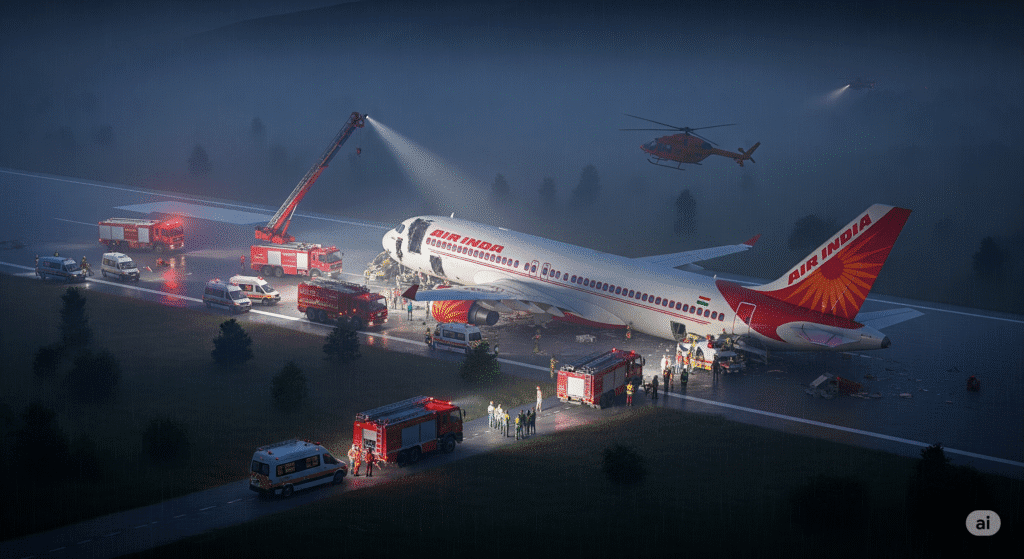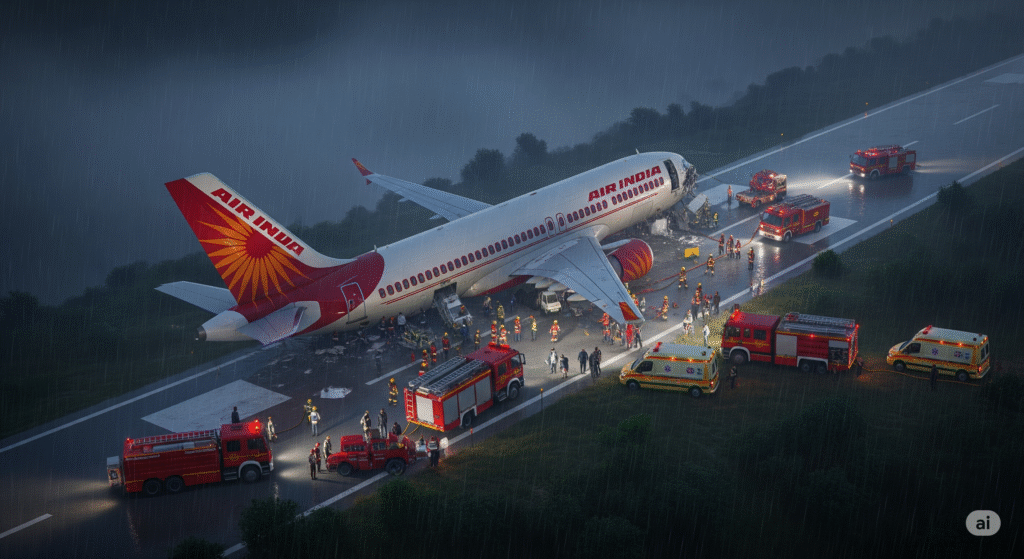Air India Crash Report: Cockpit Mystery and a Nation’s Wait for Answers
Black Box Shocker: A Mid-Air Question, a Fatal Plunge – Inside the Air India AI 171 Preliminary Report
Introduction: A Nation Demands Answers

In the somber aftermath of one of India’s most devastating aviation disasters, the Aircraft Accident Investigation Bureau (AAIB) has released its preliminary report on the crash of Air India Flight AI 171. The tragic incident involved a Boeing 787-8 Dreamliner that crashed moments after taking off from Ahmedabad on June 12, claiming 260 lives. [7, 12] The initial findings, drawn from the vital data of the recovered black boxes, have sent shockwaves through the industry, pointing not to a simple mechanical failure, but to a baffling sequence of events inside the cockpit.
The report reveals that the fuel supply to both of the aircraft’s powerful engines was cut off just seconds after it became airborne. [5, 7] This startling revelation is compounded by a chilling question captured by the cockpit voice recorder, suggesting confusion between the pilots in the flight’s final moments. [5] As a nation grieves and the global aviation community watches intently, India’s Civil Aviation Minister, K. Rammohan Naidu, has urged caution against premature conclusions, emphasizing a commitment to total transparency and accountability in the ongoing probe. [12, 22] This article delves deep into the findings of the preliminary report, the questions that haunt investigators, and the long and meticulous journey ahead to uncover the full truth behind the tragedy of Flight AI 171.
The Fateful Flight: A Dreamliner’s Tragic End
On what should have been a routine departure on June 12, 2025, Air India Flight AI 171 was scheduled to fly from Ahmedabad’s Sardar Vallabhbhai Patel International Airport to London Gatwick. The aircraft, a modern Boeing 787-8 Dreamliner, was carrying 242 individuals, including passengers and crew. [5, 7] Moments after lifting off the runway, disaster struck. The aircraft failed to gain significant altitude, plummeting from the sky and crashing into a nearby medical college hostel. [7, 13]
The impact was catastrophic, resulting in the deaths of 241 people on board and an additional 19 individuals on the ground. In a turn of events that can only be described as miraculous, one passenger survived the crash. [5, 7] The incident, being the first-ever fatal crash involving the widely-used Boeing 787 Dreamliner, immediately drew global attention and raised urgent questions about aviation safety. [16]
Inside the Preliminary Report: “Why Did You Cutoff?”
The 15-page preliminary report released by the AAIB provides a stark and unsettling timeline of the flight’s last moments. [7] The data, meticulously extracted from the flight data recorder (FDR) and cockpit voice recorder (CVR), forms the backbone of these initial findings.
The Critical Moment: A Dual Engine Shutdown
Investigators have pinpointed the central anomaly that led to the crash. Just three seconds after the aircraft lifted off the ground, the fuel flow to both engines ceased. The report states with clinical precision: “The Engine 1 and Engine 2 fuel cutoff switches transitioned from RUN to CUTOFF position one after another with a time gap of 01 sec.” [7, 8] This action starved the engines of fuel, causing them to lose power at the most critical phase of flight.
A Chilling Cockpit Exchange
Perhaps the most disturbing finding comes from the cockpit voice recorder. The audio reveals a moment of apparent confusion and shock between the experienced pilots.
“In the cockpit voice recording, one of the pilots is heard asking the other why did he cutoff. The other pilot responded that he did not do so.” [5, 7]
This brief but dramatic exchange opens a Pandora’s box of possibilities. It suggests that the cutting of fuel was an unexpected event, not a coordinated or intentional action by the crew. Investigators are now faced with the daunting task of determining whether this was an incomprehensible human error or the result of a complex, uncommanded mechanical or electrical failure. Moments after this exchange, one of the pilots transmitted a “MAYDAY, MAYDAY, MAYDAY” call, a final, desperate signal of the dire emergency they faced. [8]
Ruling Out Initial Theories
A key function of a preliminary report is to narrow the scope of the investigation by confirming or dismissing initial theories. The AAIB report has established several important facts:
- Aircraft Weight and Balance: The plane’s take-off weight of 213,401 kg was within permissible limits. [13]
- Fuel Quality: Samples taken from the refuelling tanks at the airport were tested and found to be satisfactory, making fuel contamination an unlikely cause. [5, 13]
- Aircraft Configuration: The wing flaps were at a 5-degree position, which is consistent with a standard takeoff setting. [5]
- Crew Experience: The pilot-in-command had nearly 8,600 hours of experience on the Boeing 787, and the co-pilot had over 1,100 hours. Both were well-rested before the flight. [5]
- Maintenance Records: The report notes that the throttle control module, which houses the fuel control switches, had been replaced in 2019 and 2023 for reasons unrelated to the switches themselves. Crucially, no defects related to the fuel control switches had been reported on the aircraft since 2023. [5]
Official Response: A Call for Calm and Thoroughness

In the wake of the report’s release, Civil Aviation Minister K. Rammohan Naidu has been the public face of the government’s response. He has stressed the importance of letting the AAIB conduct its work without pressure or speculation. “Very soon… AAIB is working on it… it is the responsibility of AAIB, let them do their job,” Naidu stated, while promising that the ministry is ensuring “transparency and accountability” throughout the process. [12, 22]
To bolster the investigation and address systemic issues, the government has taken swift action. A high-level, multi-disciplinary committee has been established to conduct a parallel inquiry, with a mandate to submit a report within three months. [16, 20] Furthermore, the Directorate General of Civil Aviation (DGCA) has ordered enhanced safety inspections of all 33 Boeing 787 aircraft currently in service with Indian airlines, a precautionary measure to ensure no fleet-wide issue exists. [16]
Understanding the Investigation Process
It is crucial for the public to understand that a preliminary report is not the final word. According to the standards set by the International Civil Aviation Organisation (ICAO), its purpose is to provide timely factual information to the global aviation community to aid in the prevention of future accidents. [21, 23] It does not seek to apportion blame or liability. [23]
The investigation is a painstaking process. The work continues with international cooperation, including technical experts from the U.S. National Transportation Safety Board (NTSB), as the aircraft was designed and manufactured in the United States. [18, 28] The journey to a final report, which will offer a probable cause and safety recommendations, is often long, potentially taking a year or more to complete. [11] This process involves microscopic examination of wreckage, detailed simulation of flight data, and further analysis of every component of interest.
The Broader Context: Air Safety in the Spotlight
This tragedy inevitably brings India’s aviation safety record into sharp focus. It evokes memories of past incidents, such as the 2020 crash of Air India Express Flight 1344 in Kozhikode. [3, 15] In that case, the final report pointed to non-adherence to standard operating procedures during a landing in bad weather on a challenging tabletop runway. [26, 27] While the circumstances of the Ahmedabad crash are vastly different, both events underscore the critical importance of rigorous procedures, crew resource management, and robust regulatory oversight.
The global significance of the AI 171 investigation cannot be overstated. As the first fatal accident for the Boeing 787, airlines, regulators, and manufacturers around the world are awaiting the final conclusions, which could have far-reaching implications for the aircraft’s operation and design. [16]
Conclusion: Unanswered Questions and the Painful Wait
The preliminary report into the crash of Flight AI 171 has answered the question of *what* happened in the final moments but has left the world asking *why*. The central mystery remains unsolved: what led to the fuel cutoff switches being activated? Was it a freak mechanical or electrical malfunction that overrode the pilots’ commands? Was it a tragic, inadvertent human error in a high-stakes moment? Or was it an action whose intent is not yet understood?
As investigators work tirelessly to piece together the final moments of the flight, the words of the Aviation Minister echo as a necessary refrain: patience is paramount. For the families who have lost loved ones, the wait for definitive answers is agonizing. For the aviation industry, these answers are essential to upholding the sacred trust of passenger safety. The path forward is one of meticulous science, painstaking analysis, and an unwavering commitment to uncovering the truth, however complex and unsettling it may be.
